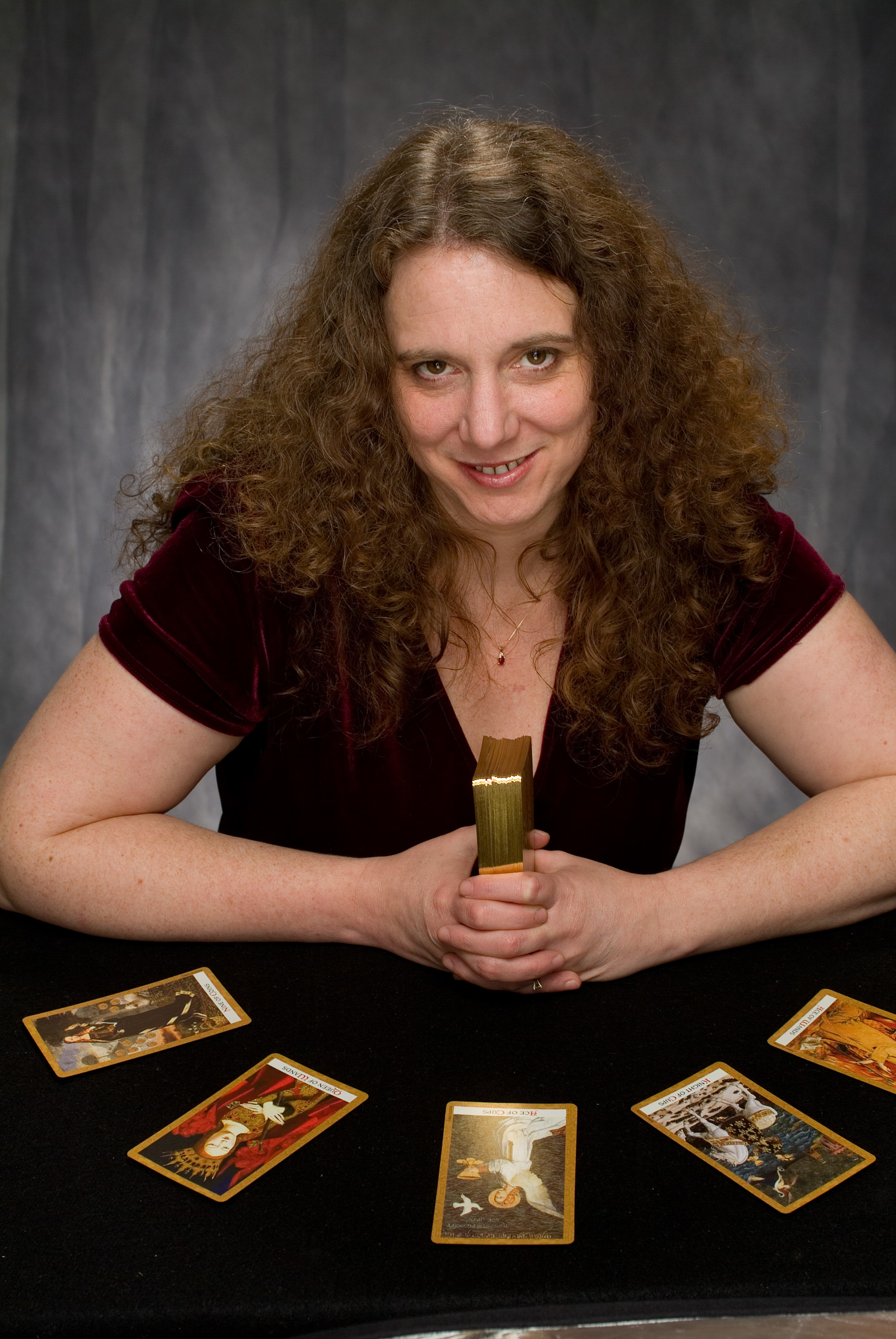
Welcome to my personal blog.
Here you will find my musings, thoughts and observations, all inspired by my experiences as a full-time professional tarot reader.
Some Thoughts on Three-Card Tarot Spreads
Three-card spreads are perhaps the most popular tarot-reading technique. Here is some information about them, some advice on using them, and some reasons why they can't be the only tool in the tarot toolbox.
Some Thoughts on Three-Card Tarot Spreads
When I took my first tarot classes thirty-five years ago, three-card readings were one of the first things we learned to do, after learning the seventy-eight cards.
Many cultures consider the number Three to be the most powerful and sacred number. We might say that the power of that number is conferred to the reading when we use that number of cards. Perhaps that is one reason three-card readings are so popular.
Three-card readings are a great tool for teaching tarot because it is the smallest number of cards one can use to teach complex reading techniques that connect the cards together to create a cohesive message or story.
Three-card readings can be positioned or non-positioned. A positioned spread is when each of the three positions has a meaning that gives context to the card that falls within in. A non-positioned spread is when you simply pull three cards and find messages within them, without ascribing positional meanings to each card.
It is important to learn to do both kinds of tarot spreads.
Three-card readings, both positioned and non-positioned, are great exercises for tarot students at all levels of study. Three-card readings, both positioned and non-positioned, are a great tool to answer specific questions within the scope of a longer tarot-reading session.
There are many great three-card spreads, such as Past/Present/Future, Body/Mind/Spirit and Morning/Afternoon/Evening. I very often devise tarot exercises that are based on three cards.
When reading a three-card positioned spread, we need to work the context of each position into our reading.
Many people use Past/Present/Future to answer questions of any kind. The technique to do that effectively is to think about how the Past card reflects the situation in the past only if that makes sense in the context of the question. If it doesn’t, use the Past card to think about the energies you are bringing into the situation. Perhaps you have encountered similar situations in the past. Things that have happened in the past could inform the current situation.
The Present card will give direct information about the current situation. What is going on with it right now? How do you feel about it? How does this card match your feelings about the situation?
The Future card will give a prediction for how the situation will resolve or offer advice for the situation going forward. This card may help you make decisions about the situation at hand. Often, a view of a possible outcome can wisely inform our decisions.
When using a non-positioned spread, you have the freedom to move the cards around and see how they fit together in various ways. You can form a story, or a sentence, or you can take aspects of each card and see how they tie in together.
Working with both kinds of three-card spreads builds our skills as readers.
Lately, I have noticed that some readers seem to stop developing skills at this point. They don’t learn to interpret larger spreads, or to incorporate other tarot divination techniques. I notice readers offering three-card spreads in professional settings, and very often complaining that their businesses aren’t growing as quickly as they would like.
If you are a tarot pro and have found a three-card technique that is working for you, that’s excellent. Don’t fix what isn’t broken. But, if you aren’t happy with how your business is going, consider that your reliance on such a small spread in the professional setting might be part of the problem.
I often use three-card spreads in professional sessions, but only as part of the session. I use multiple spreads and techniques in any tarot session, even if that session is a five-minute reading in a party setting.
If you are interested in growing your skills as a reader, or growing your business as a tarot professional, work to master the three-card reading, and grow beyond it. That doesn’t mean you should stop doing three-card readings, it means you should develop numerous divination techniques and learn to combine them as each situation dictates.
Three-card readings are an important tool in our tarot toolbox. But they shouldn’t be the only tool we have.
Spreads, Pulls and Dialogues
A good tarot practice involves multiple techniques. Some readings require positioned spreads, other require a different treatment. Here are six proven ways to get the information you need from your tarot cards.
Spreads, Pulls and Dialogues
Six Proven Tarot Techniques
The explosion of tarot popularity means there are ever-more folks learning and sharing tarot. This is an awesome thing! Yet, it also means, with more voices in the mix, that there is more room for confusion and misinformation.
Tarot is an interesting thing in that there is no one right way to do things. There are multiple traditions. Since tarot is a tool of creativity, we are discovering new techniques all the time.
The downside is that many new tarotists end up confused, finding that the techniques they have learned fall short in delivering pertinent information.
Here, then, is a short primer on some of the most effective ways to work with your cards in divination.
Comprehensive Spreads
A comprehensive spread is a spread that has positional meanings for many departments of life. The Celtic Cross, the Seven Sisters and the Astrology Wheel are all comprehensive spreads. When using these spreads, it is often best not to have a specific question in mind. Just be open to what the universe has to say and interpret the cards in the context of the positions in which they fall. You may find that a comprehensive spread generates questions that you will want to use other techniques to answer.
If you are interested in learning to master a modern Celtic Cross, and comprehensive spreads in general, you can take my video class.
Topical Spreads
A topical spread is a positioned spread designed for a specific purpose, to answer a specific type of question. The Body/Mind/Spirit three-card spread is great to check in on overall well-being. A relationship spread is great to check in on a relationship. A career spread is helpful in understanding your career direction.
You can find many of these types of spreads online and in books. Use them when you have a specific type of question.
Custom Spreads
A custom spread is a positioned spread that you create for a specific issue. Imagine you had a dream you wanted to interpret. You could create one position for each element of the dream and add a position for each question you have about the dream.
If you were having trouble with a specific relationship you could create one position for each question you have about the relationship.
If you are making a decision you may have one card as the result of choosing each option, or two cards for each option, letting one card give the pro of that choice, and the other, the con. You may use a custom spread only once, or you may create a spread that you save to use again the next time a similar situation arises.
Non-Positioned Spreads
A non-positioned spread is a specific number of cards pulled in answer to a question, where none of the positions have meaning. You might read the cards as a sentence, or as a sequence of events. Or, you might blend the meanings of the cards together to get your answer. You might rearrange the order of the cards in a way that makes more sense to you.
There are two kinds of non-positioned spreads. One kind of non-positioned spread is to simply pull three cards and read them in whatever way makes sense. It’s usually not advisable to try to use more than three or four cards with this technique. Non-positioned spreads of five or six or more are usually quite confusing, unless you try the following technique.
The second type of non-positioned spread involves more cards, maybe six or as many as nine. Here, however, the reader generally has a protocol for reading the spread. Even though there are not specific positions, they may read cards on the bottom as the past, for example, or cards on the end of the row as outer influences and cards in the middle as inner influences.
Use of these non-positioned spreads is usually a matter of reader preference. They allow for greater leeway in interpretation than a positioned spread, yet lack the structure a positioned spread can offer.
Single Card Pulls
A single card pull is exactly what it sounds like. Ask a question and pull a card in answer. If the card you received doesn’t easily answer your question, you have two choices. One is to meditate on the card, research the card and spend time in contemplation to derive its message. The other is to expand your single card pull into a tarot dialogue.
Tarot Dialogues
A dialogue is a conversation with the cards. Ask a question and pull one card in answer. If the answer isn’t clear, pull one or two more – as many cards as intuition tell you to pull. Within that string of cards find a story, or extenuating information pertinent to your question. Does another question arise from this answer? Shuffle all the cards you pulled back into the deck and ask that question. Again, pull a card, or a string of cards, to get that answer. Does that generate a further question? Continue the process until you have a clear view of what is going on. If one or two cards keep repeating, take that as an overall message of supreme importance.
Whatever technique you use to read your cards, you will find that some cards seem very clear, and others confuse you. Do not dismiss the confusing cards. Recognize those cards as an opportunity for deeper contemplation and introspection. You may pull a card to clarify a confusing card. I think it is best to save clarifiers only as a last resort, and to not use them habitually.
In positioned spreads, you might find that some cards make sense to the situation, but not in the position they appear. It’s okay to use the positions as a guide, without being too rigid. Find the value in the cards that appear and know that sometimes the positions will be absolutely poignant in their accuracy, and other times the cards will scream truth while the positions will fade into the background.
To get the most out of tarot, it’s important to learn as many techniques as you can, because different circumstances call for different approaches. As you practice, read for as many people as you can. Read for yourself and keep a record of your self-readings. With tarot, the more you read, the more you will learn the specific and unique ways in which the cards speak to you. Do not wait until you are off-book to begin practicing. It is in the practice of reading that you will learn to memorize the cards and understand their wisdom.



